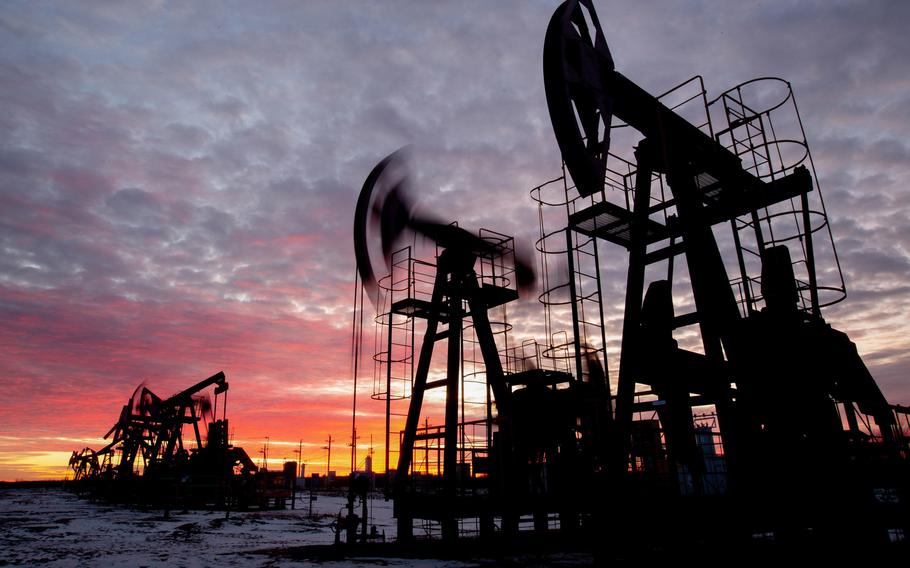Middle East
OPEC+ agrees to revive more output as market looks tighter
Bloomberg January 4, 2022

Oil pumping jacks operate in an oilfield near Neftekamsk, in the Republic of Bashkortostan, Russia, on Nov. 19, 2020. MUST CREDIT: Bloomberg photo by Andrey Rudakov. (Andrey Rudakov/Bloomberg)
OPEC and its allies agreed to revive more halted production as the outlook for global oil markets improved, with demand largely withstanding the new coronavirus variant.
The 23-nation alliance led by Saudi Arabia and Russia approved the 400,000 barrel-a-day increase scheduled for February at a meeting on Tuesday, according to a statement. The group is sticking to its plan to gradually restore output halted during the pandemic after its analysts predicted a smaller surplus this quarter than previously expected.
Global fuel consumption continues to recover from 2020’s collapse. There’s rising traffic and factory activity across key Asian consuming countries and dwindling crude inventories in the U.S., buoying oil prices to nearly $80 a barrel in London.
OPEC+ has already restarted about two-thirds of the production they halted in the early stages of the pandemic. They are seeking to drip-feed the remainder at a pace that will satisfy the recovery in fuel consumption -- and stave off any inflationary price spike -- without sending the market into a new slump.
There are questions about whether OPEC+ will can actually deliver the full monthly increment, given the recent struggles of some members such as Angola and Nigeria to hit their production targets.
Just 130,000 barrels a day of additional OPEC+ crude are likely to hit the market in January, followed by 250,000 barrels a day in February, according to Amrita Sen, chief oil analyst and co-founder at Energy Aspects Ltd.
“Even if that headline number is 400,000, what’s coming to the market is half of that, maybe even less,” Sen said in an interview with Bloomberg TV before the OPEC+ meeting.
While the Organization of Petroleum Exporting Countries and its partners still expect a supply surplus to emerge this month, it appears to be smaller than previously thought. The increasing price premium of near-term Brent crude futures over later-dated contracts suggest the market remains tight.
Production will exceed demand worldwide by 1.4 million barrels a day in the first three months of the year, the group’s Joint Technical Committee concluded on Monday, compared with 1.9 million in its previous assessment.
The cartel isn’t concerned about adding barrels at a time of surplus because fuel inventories are currently at low levels and typically replenish during the seasonal demand lull, according to a delegate. Stockpiles in developed nations were 85 million barrels below their average from 2015 to 2019 as of November, according to the JTC.
At a separate and very brief online meeting on Monday, OPEC ministers appointed veteran Kuwaiti oil executive Haitham Al-Ghais as its new top diplomat, to assume the post in August after the term of its current Secretary-General Mohammad Barkindo expires.
Proceeding with the next monthly increase isn’t without risks for the producers’ alliance.
Air travel saw significant disruption in the U.S. last week, with more than 1,300 flights canceled on Friday and 1,000 scrubbed for Saturday as carriers struggled with staff shortages related to coronavirus infections.
China, Asia’s biggest oil user, has shown signs of weakening fuel demand because of its relentless zero-Covid approach and tough line on pollution, according to road-congestion data from local providers like Baidu Inc. Goldman Sachs Group Inc. expects the country to maintain border restrictions for the rest of this year as it prepares to host the Beijing Winter Olympics and a series of political events.
And while OPEC’s analysts see a tighter first-quarter, a chunk of the surplus they previously anticipated has been deferred to later in the year. The group has said several times that it has the option of pausing or even reversing its scheduled supply increases if needed.
The group will hold its next meeting on Feb. 2.
- - -
Bloomberg’s Olga Tanas and Paul Wallace contributed to this report.